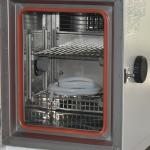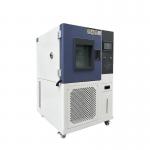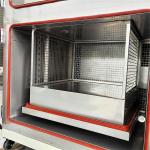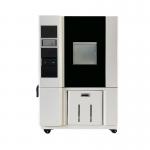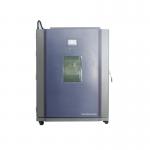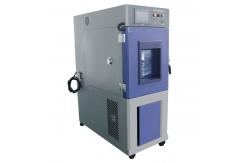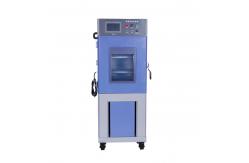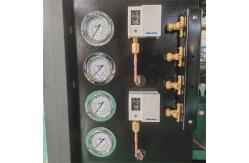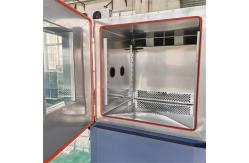In the realm of modern product development and quality assurance,
the ability to precisely control and simulate diverse environmental
conditions is non-negotiable. The Customization Programmable Auto
Test High Low Temperature Humidity Chamber emerges as a versatile
and powerful solution, designed to meet the most demanding
requirements of various industries. This advanced chamber is engineered to create and maintain highly
accurate and customizable temperature and humidity settings. It is
a cornerstone in industries such as electronics, automotive,
pharmaceuticals, and materials science. The primary purpose is to
conduct comprehensive and automated tests on a wide range of
products and materials. By subjecting them to extreme temperature
and humidity conditions, manufacturers and researchers can evaluate
their performance, durability, and reliability. The programmable
and customizable features allow for the replication of specific
real-world scenarios, ensuring that products can withstand the
rigors of their intended applications and comply with industry
standards. - Robust and Modular Construction
- The chamber is constructed with a heavy-duty framework, typically
made of corrosion-resistant steel, ensuring its durability and
stability. The exterior is designed to withstand the rigors of a
laboratory or production environment, protecting the internal
components. The interior is lined with a non-reactive and smooth
surface, such as stainless steel or a specialized polymer, to
prevent any interaction between the chamber and the tested
specimens. The modular design allows for easy customization and
expansion. It can be configured with adjustable shelves, racks, and
compartments to accommodate different sample sizes and testing
setups. This modularity also simplifies maintenance and upgrades,
ensuring the long-term viability of the chamber. The door of the
chamber is engineered for a perfect seal and smooth operation. It
features a reliable locking mechanism and a heavy-duty gasket,
which can endure the pressure differentials caused by temperature
and humidity changes. The door also includes a large viewing
window, usually made of tempered glass with anti-fog and
anti-scratch properties, enabling continuous visual monitoring of
the testing process without disturbing the internal environment.
- Precision Temperature and Humidity Control Systems
- Temperature Control: The temperature control system is highly
accurate and can maintain a wide temperature range, typically from
-70°C to +180°C, with an accuracy of ±0.3°C. It utilizes advanced
refrigeration and heating technologies, along with a sophisticated
feedback loop and multiple temperature sensors strategically placed
throughout the chamber. This ensures uniform temperature
distribution and rapid temperature change capabilities, essential
for efficient thermal cycling experiments. The system also has
built-in safety features to prevent overheating or overcooling,
protecting both the samples and the chamber itself.
- Humidity Control: The humidity control system is equally precise,
capable of adjusting the relative humidity from 5% to 95% RH, with
an accuracy of ±2% RH. The chamber is equipped with a
high-efficiency humidifier and dehumidifier, which work in harmony
to achieve rapid and accurate humidity adjustments. Special care is
taken to prevent condensation, which could affect the test results
and damage the samples. The system also features a dew point
control function, which is crucial for maintaining the integrity of
the internal climate.
- Programmability: The chamber's control panel is highly
programmable, allowing users to create and store complex
temperature and humidity profiles. This enables the simulation of a
wide variety of environmental conditions, from simple static
settings to intricate cyclic and stepwise changes. For example, it
can mimic the temperature and humidity fluctuations that a product
might experience during a year-long outdoor exposure or the rapid
changes during a manufacturing process. The control panel is
user-friendly and intuitive, with a clear display that shows the
current temperature, humidity, and the status of the testing
program.
- Automated Testing Capabilities
- The chamber is equipped with advanced automation features. It can
be programmed to start and stop tests at specific times, adjust
temperature and humidity settings automatically, and record data
continuously. This automation not only saves time and effort but
also ensures the consistency and accuracy of the testing process.
The system can also be integrated with external software and
databases, facilitating seamless data transfer and analysis. It can
be configured to send notifications and reports automatically,
keeping users informed about the progress and results of the tests.
Additionally, the chamber has built-in safety features and alarms
that can detect abnormal conditions, such as temperature or
humidity excursions outside the set limits, power failures, or
equipment malfunctions, and take appropriate actions to protect the
samples and the chamber.
- Advanced Instrumentation and Data Acquisition
- The chamber is outfitted with a comprehensive suite of sensors.
Temperature sensors are distributed evenly to detect any
temperature gradients and ensure a homogeneous thermal environment.
Humidity sensors provide real-time data on the relative humidity
levels. These sensors are connected to a state-of-the-art data
acquisition system that records and stores all the measured data.
The data can be accessed and analyzed in real-time or retrieved
later for in-depth studies. The data acquisition system is highly
flexible and can be integrated with external software and
databases, facilitating seamless data transfer and analysis. It can
also be configured to send notifications and reports automatically,
saving time and effort for the users.
- Volume and Dimensions: The chamber is available in a variety of sizes to suit different
testing needs. It can range from compact benchtop models with a few
cubic feet of volume to large walk-in chambers that can accommodate
substantial quantities of samples. The interior dimensions are
carefully designed to optimize the distribution of temperature and
humidity, ensuring that all samples are exposed to consistent
conditions. The external dimensions are configured to fit within
the available space in a laboratory or production facility, taking
into account factors such as access, ventilation, and clearance.
- Temperature Uniformity: The temperature uniformity within the chamber is maintained
within ±0.5°C. This ensures that all parts of the tested samples
experience a similar thermal environment, which is crucial for
obtaining accurate and reliable test results.
- Humidity Uniformity: The humidity uniformity is within ±3% RH. This level of
consistency in humidity distribution allows for precise testing of
samples that are sensitive to moisture levels.
- Stability: Both the temperature and humidity stability are excellent, with
minimal fluctuations over time. This allows for long-term testing
and the evaluation of a sample's performance under stable
environmental conditions, as well as its ability to withstand
changes over extended periods.
- Accurate Simulation of Extreme Environments
- The primary function of this chamber is to provide a highly
accurate and realistic simulation of specific high and low
temperature and humidity conditions. By precisely controlling these
parameters, it allows manufacturers to evaluate how products will
behave in various real-world situations. For example, in the
automotive industry, it can test the performance of engine
components under extreme heat and humidity, ensuring their
reliability in different climates. In the electronics industry, it
can assess the durability of circuit boards and components in harsh
temperature and humidity conditions, preventing issues like
corrosion and short circuits.
- The ability to create complex environmental profiles, such as
cyclic temperature and humidity changes, is also a valuable
function. This can help in uncovering potential weaknesses or
failure points in products that may not be evident under static
conditions. For instance, a product that is exposed to daily
temperature and humidity cycles may experience stress-induced
damage over time, and this chamber can accurately replicate such
scenarios.
- Enhanced Product Quality and Reliability
- Through comprehensive testing in the chamber, manufacturers can
identify and address potential issues in their products. If a
product shows signs of degradation or failure under specific
temperature and humidity conditions, appropriate measures can be
taken, such as modifying the design, changing the material
composition, or improving the manufacturing process. This leads to
the development of more stable and reliable products, reducing the
risk of in-field failures and product recalls. It also helps in
optimizing product warranties and service intervals, as
manufacturers have a better understanding of the product's
durability under different environmental stressors.
- The test chamber also serves as a powerful tool for research and
development. It allows engineers and scientists to study the
effects of temperature and humidity on new materials and product
designs. For example, in the field of materials science, the
chamber can be used to investigate the phase transitions and
mechanical properties of materials under different environmental
conditions, leading to the discovery of new materials with improved
performance and durability.
- Compliance with Industry Standards and Regulations
- Many industries have strict standards and regulations regarding
product testing in specific temperature and humidity conditions.
The Customization Programmable Auto Test High Low Temperature
Humidity Chamber is a reliable tool for ensuring compliance. In the
pharmaceutical industry, products need to meet certain temperature
and humidity requirements to ensure their safety and efficacy. In
the aerospace industry, components must withstand the extreme
environmental conditions of space and flight. By using this chamber
to conduct tests in accordance with relevant standards,
manufacturers can prove that their products meet the necessary
criteria, facilitating market access and enhancing consumer
confidence. Regulatory bodies rely on accurate test results
obtained from such chambers to enforce safety and quality
regulations.
- Stringent Manufacturing Process
|
